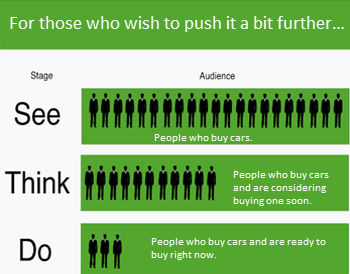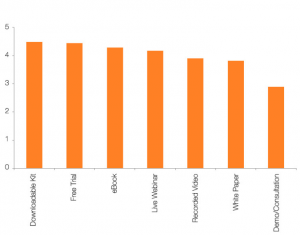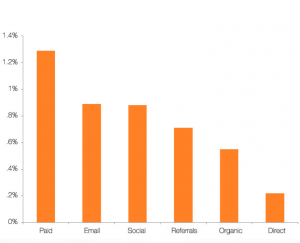Inbound marketing’s reputation as an online sales strategy and process is already proven and when we discuss inbound marketing, we must talk about content marketing and editorial strategies.
A thought-provoking content strategy is indisputably essential—whether it’s to improve your company’s search engine positioning, to make it a front runner or expert in its field, to develop an unparalleled user experience, or simply to increase its web strategies’ performance.
The editorial is an extraordinary marketing tool. There is no debate. Billions of searches per day, smart searches, voice searches, and it continues to evolve with all the new small search engines that are emerging.
In fact, the only difference between content creation and advertisement creation is that your prospects search for your content, whereas they are bombarded with advertising messages on a daily basis.
In short, whether you are in B2B or B2C, nowadays content marketing is the weapon of choice in marketers’ arsenal
90% of B2C and 93% of B2B marketers currently use content marketing in their web strategies, according to this study of more than 7000 North Americans published by Hubspot.
According to a 2013 study carried out by the Content Marketing Institute, 86% of B2C marketers plan to maintain or increase the budgets allocated to content marketing in the coming years.
If you are in B2B, the same intention is evident. 54% of B2B marketers plan to increase their allocations for this type of online marketing.
 Integrate content strategy into the rest of your marketing activities
Integrate content strategy into the rest of your marketing activities
Robert Rose, Chief Strategist at the Content Marketing Institute highlighted an important shortcoming in his article“How Content Marketing Success is Blocked by Antiquated Beliefs,” which was that content marketing is regarded as an avenue independent of all other marketing activities.
You may have produced very relevant content, but if it lacks the support of relevant communication channels and is not incorporated into a customized inbound process, the results won’t be very encouraging.
To ensure that it is fully incorporated and obtains optimal results, a content marketing strategy is developed through key steps. In this article, the important elements to consider during the development of your content strategy are highlighted.
1. Preliminary research
1.1. Understand the business and its internal and external goals
Whether for your business or a client, take the time to study the company’s marketing plan and to fully understand the industry in which it is involved. This will enable you to better understand its issues, challenges, positioning, opportunities, and constraints.
In this research stage, particular attention should be paid to the following elements.
- Analyzing the company’s products and services, and its strengths and weaknesses compared to the competition. I believe this is vital.
- Evaluating the company’s social media performance. Audience, traffic generation, and conversion rate.
- Assessing the role of organic traffic in traffic generation and conversion.
- Evaluating the profile of inbound links, which is important in assessing the relevance attributed to actual content.
- Understanding the company’s content production capabilities, internally and externally.
- Reviewing contact lists. How many subscribers and what does this channel contribute.
- Evaluating the current lead generation process.
- Studying the same elements among the competition. You’ll be surprised what you can learn from your market competition.
1.2. Defining the target personas
Defining the target audience is not as easy as it seems. Defining the typical client profile is fine, but understanding their online buying process is vital to determining their content needs. Identifying the key steps in your personas’ buying process will enable you to better understand their challenges and to better respond to their questions through your content.
2. Content planning
2.1. Setting SMART goals
Before creating a strategy, it is essential to know in which direction to align your efforts. Ensure that you have properly identified your content strategy’s goals. They must be clear and measurable, fall within a given time period, and, above all, be realistic as a whole. Make sure that you are as specific as possible in setting your goals.
2.2. Identify content opportunities
- Web Analytics report
Study your users’ behaviour, what they click, what they seem to be looking for, the content that most interests them, and the key words they use to perform their searches, through both search engines and directly on your Web site. This will help ascertain their information needs.
- Key word search
Perform a search to identify the key words and expressions used by your prospects in their searches. You can use several tools to ascertain search tendencies, including Google Trends or the Keyword Planner, to estimate search volumes in a given period and identify signs of interest towards the product in particular.
- Study the competition’s content strategy
On what point can you really stand out and add value that your competition fails to offer? What is your competition’s highest performing content.
 2.3. Planning content for each step of the Inbound Marketing process
2.3. Planning content for each step of the Inbound Marketing process
During his last content strategy conference in Montreal, Yan Desjardins, VP Marketing here at Ludis Media, took the time to explain the different purposes that content can have.
In short, your content should seek to:
- Entertain
- Educate
- Inspire
- Persuade
To delve deeper into this analysis, let’s consider Avinash’s content creation model.
When Avinash published his article “See-Think-Do: A Content, Marketing, Measurement Business Framework,” he summarized the online buying process, dividing it into three major stages.
SEE: The discovery stage in which the content created is aimed at informing prospects of your brand’s existence, interesting them in your brand, and enhancing your company’s online reputation to position it among the available options when the decision is made. Generally, this content’s goal is to entertain and educate your prospects and consequently engage in interactions with them, as they are not yet ready to buy.
THINK: The content created for this stage is geared towards inspiring prospects and persuading them of your company’s suitability. More sophisticated content is frequently used, such as case studies, presentations and webinars, and other types of educational content, all while showcasing your business. In this stage, you communicate with your prospects who are thinking about taking the next step. Therefore, they are looking for specific content that will enable them to properly assess their options.
DO: Your intended prospects are ready to take action. Here you must consider developing the final content of your sales funnel. A free trial, a free consultation if you offer services, a promotional discount, or other element that will enable you to convert this interest into a decision to buy.
 2.4. Types of content ranked by user preference
2.4. Types of content ranked by user preference
Last year, Hubspot published the results of a study conducted in North America to highlight the greater interest in certain types of content over others. The responses compiled here are based on the value users attribute to the type of content. Keep them in mind when developing your offers to optimize your conversion rate.
3) Determining the right communication medium
To make content visible to the right people, use every relevant medium to promote it.
- Optimize this content for search engines.
- Integrate your social media to boost this content’s visibility.
- Include sharing buttons on various relevant social media platforms.
- Don’t overlook e-mail communications: Use newsletters and lead nurturing to convey your offers directly to your contact lists.
- Be aware of the synergy between platforms: sharing buttons in e-mails, newsletter subscriptions via social media, using PPC to promote content, etc. Be creative.
- Optimize the user experience to better target your offers. Always enables you to offer the right content to the right person.
- Explore the various content curation platforms
- Identify and use social media influencers to increase visibility. Followerwonk and tweepi are great tools for discovering your industry’s key influencers.
4) Conversion strategy
For optimal integration in your leads generation process:
- Develop landing pages to fit your offers.
- Display call to action buttons to trigger interaction.
- Optimize your forms: Newsletter subscriptions, e-book downloads, free consultation registrations, etc. Each stage of the buying process is unique. Put yourself in the user’s shoes by remembering Avinash’s model.
5) Monitoring
How do you assess the relevance of your efforts if you don’t follow the results achieved?
- Number of visits and conversion rate: Comments, social media shares, and assisted conversions by content
- Various platforms’ performance in generating traffic and leads.
- Inbound links profile and domain authority.
- Number of newsletter subscriptions vs. number of cancellations: Analyze your sent e-mail conversion rates.
Needless to say, you should follow the progress of all goalsset, based on the situation and the strategy.
There you have it! This is content marketing strategy. Hopefully, this will be of help when you develop your next campaign.
I look forward to discussing this topic with you.
Salim
Latest posts by Salim Ammara
- 12 tricks to improve your Facebook marketing campaigns - 15 July 2014
- How to develop a content marketing strategy - 5 June 2014
























